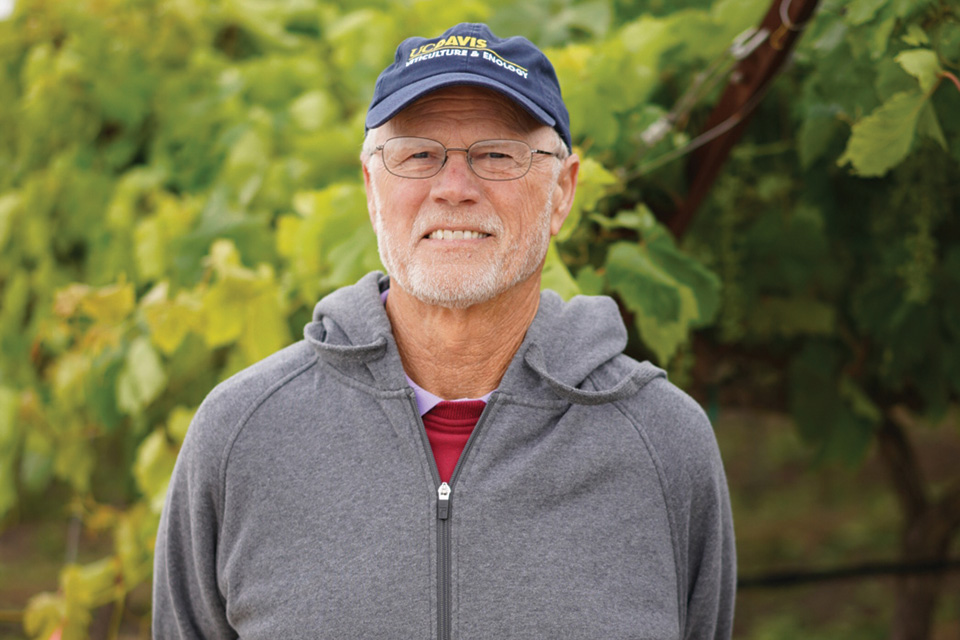How Knowledge-Based Irrigation Benefits Grape Growing

Professor Larry Williams, University of California, Davis (Photo: UC Davis)
The Department of Viticulture and Enology at the University of California, Davis recently held a vineyard water management seminar to commemorate the career of Professor Larry Williams. Over the course of his 36 years at UC Davis, Williams studied many aspects of grapevine water use and, in so doing, addressed some of the most important questions growers may have on irrigation management. Williams summarized his findings in a comprehensive exit seminar.
What Time is Best?
One of the most fundamental questions in irrigation management is: “When to initiate irrigation each season?” Williams identified several strategies to consider, including: a) attainment of allowable soil water depletion, which can be measured with a neutron probe or other instrument; b) water budgeting, which requires knowledge of soil water holding capacity, rooting depth, and annual vineyard water use; and c) a plant-based method such as attaining a leaf water potential threshold.
Williams showed that mid-day leaf water potential measurements were well correlated with soil water content and suggested that any of these methods could be used to determine when to start irrigating. Therefore, he suggested growers use techniques that are most comfortable for them.
How Much?
Once the decision has been made to irrigate, the next question that needs answering is: “How much water to apply?” The potential amount of water evaporated and transpired by a vineyard (ETc) is the product of reference evapotranspiration (ETo) and the grape crop coefficient (Kc). A network of weather stations throughout California (CIMIS) report local ETo, but growers need to develop an appropriate Kc, and Williams conducted extensive research to determine how they could do this.
Williams found that Kc was equal to 0.017 x the percent shaded area (expressed in whole numbers) of the vineyard at mid-day. The shaded area, and thus the Kc, increases with canopy size and is also affected by trellis design and row spacing. He determined shaded area by analyzing pictures taken with a digital camera, but shaded area (or canopy cover) can be measured in a number of different ways and used to develop a crop coefficient.
The crop coefficient relates evapotranspiration of a disease-free crop under optimum soil water and fertility conditions, so the equation ETc = ETo x Kc predicts water use under non-limiting conditions. Williams reviewed several trials he conducted to determine whether grapevines should be irrigated at 100% ETc, or some fraction thereof. He found that yield and quality of raisin, table, and wine grapes were generally optimal at some fraction of ETc, which contributed to the wide adoption of sustained deficit irrigation strategies.
What is Optimal?
The definition of optimal yield and quality will vary according to the type of grape being grown (raisin, table, or wine) and other considerations. Therefore, Williams developed models to show how a broad range of deficit irrigation strategies may affect vine growth, fruit yield, and quality of many types of grapes grown across the state. For example, irrigating at 80% ETc maximized berry weight of ‘Thompson Seedless’ table grapes.
Many other speakers, from academia and industry, paid tribute to Williams and offered their perspectives on irrigation management. Several new technologies that offer the potential to simplify or improve irrigation management strategies were discussed. For example, Dr. Ken Shackel, a plant scientist at UC Davis, is testing a sensor which can continuously measure plant water potential, thereby providing real-time monitoring of plant water stress. Dr. Andrew McElrone, USDA-ARS, and Dr. Thomas Shapland, Thule Technologies, discussed the surface-renewal method for direct measurement of ETc, a technology that was validated, in part, in collaboration with Williams.
Thanks to Williams and his collaborators, grape growers can implement informed irrigation strategies that optimize yield and quality while saving water.










